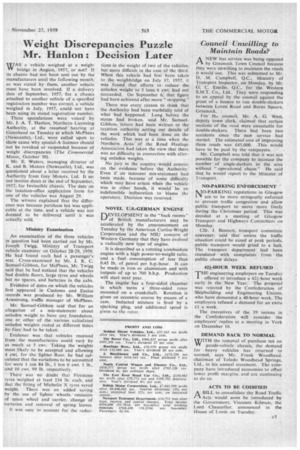Weight Discrepancies Puzzle Mr. Hanlon : Decision Later
Page 45

If you've noticed an error in this article please click here to report it so we can fix it.
WAS a vehicle -weighed at a weighbridge in August, 1957, or not? If its chassis• had not been sent out by the manufacturers until the following month. as was stated by them, another vehicle must have been involved. If a delivery date of September, 1957, for a chassis attached to another vehicle of a specified registration number was correct, a vehicle weighed in July, .1957, could not have been using its stated registration number.
These speculations were voiced by Mr. J. A. T. Hanlon, Northern Licensing Authority, at the resumed hearing at Gateshead on Tuesday at which McPhees (Newcastle),-, Ltd., were called upon to show cause why special-A licences should not be revoked or suspended because of weight discrepancies (The ,Commercial Motor, October 30).
Mr. E. Waters, managing director of K. and B. Motors (Newcastle), Ltd., was questioned about a letter received by the Authority from Guy Motors, Ltd. It set out invoice dates at the end of September, 1957, for Invincible Chassis. The date on the taxation-office application form for one of the vehicles was August 29.
The witness explained that the difference was because purchase tax was applicable at the time. and a vehicle was not deemed to be delivered until it was actually sold.
Ministry Examination An examination of the three vehicles in question had been carried out by Mr. Joseph Twigg, Ministry of Transport vehicle examiner on October 28-29, 1959. He had found each had a passenger's seat. Cross-examined by Mr. J. R. C. Samuel-Gibbon, for McPhees, Mr..Twigg said that he had noticed that the vehicles had double floors, large tyres and wheels but no spares, and batteries in the cabs.
Evidence of dates on which the vehicles first appeared in Customs and Excise records was produced by Mr. William Armstrong, traffic manager of McPhees.
Mr. Samuel-Gibbon said that for an allegation of a mis-statement about unladen weight to have any foundation. one or other of the various calculated unladen weights stated at different times by Guy had to be taken.
Evidence was that vehicles received from the manufacturers could vary by as much as 5 cwt. Taking the weights most likely to be accepted and allowing 4 cwt. for the lighter floor, he had calculated that the variations to be accounted for were 1 ton 84 lb., I ton 6 cwt. 1 lb., and 16 cwt. 99 lb. respectively.
There was no doubt that Firestone tyres weighed at least 134 lb. each, and that the fitting of Michelin X tyres saved weight. There was an added saving by the use of lighter wheels, omission of spare wheel and carrier, change of .batteries and removal of spring leaves.
It was easy to account for the reduc
tions in the weight of two of the vehicles, but more difficult in the case of the third. When this vehicle had first been taken to the weighbridge on July 17, 1957, it was found that efforts to reduce the unladen weight to 5 tons 6 cwt. had not Succeeded. On September 6; that figure had been achieved after more " stripping."
There was every reason to think that the Authority had been truthfully told of what had happened. Long before the storm had broken, said Mr. SamuelGibbon, letters had been written to the taxation authority setting out details of the work which had been done on the vehicles. This was at a time when the Northern Area of the Road Haulage Association had taken the view that there was no difficulty in connection with altering unladen weights.
No jury in the country would convict on the evidence before the Authority. Even if an innocent mis-statement had been made, because of some difficulty which may have arisen when the vehicle was in other hands, it would be an indefensible indiscretion to blame the operators. Decision was reserved.
NOVEL U.S.-GERMAN ENGINE
DEVELOPMENT in the "back rooms" of British manufacturers may be accelerated by the announcement on Tuesday by the American Curtiss-Wright Corporation and the NSU concernof Western Germany that they have evolved a radically new type of engine.
It is described as a rotating combustion engine with a high power-to-weight ratio, and a fuel consumption of less than 0.45 lb. of petrol per h.p.-hour. It can be made in iron or aluminium and with outputs of up to 700 b.h.p. Production will start next year.
The engine has a four-sided chamber in which turns a• three-sided rotor mounted on a crankshaft. Rotation is given an eccentric course by means of a cam. Inducted mixture is fired by a sparking plug, and additional speed is given to the rotor.
















































































































